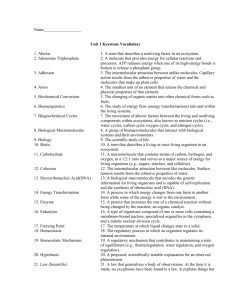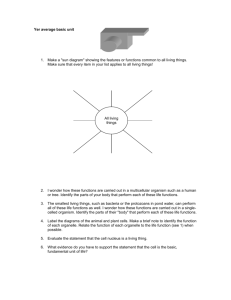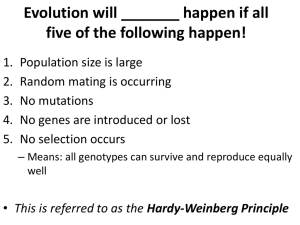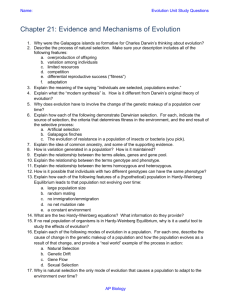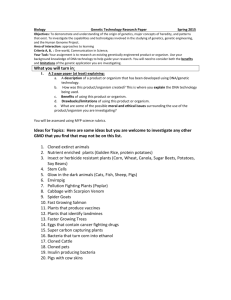Flashcard Set Three
advertisement
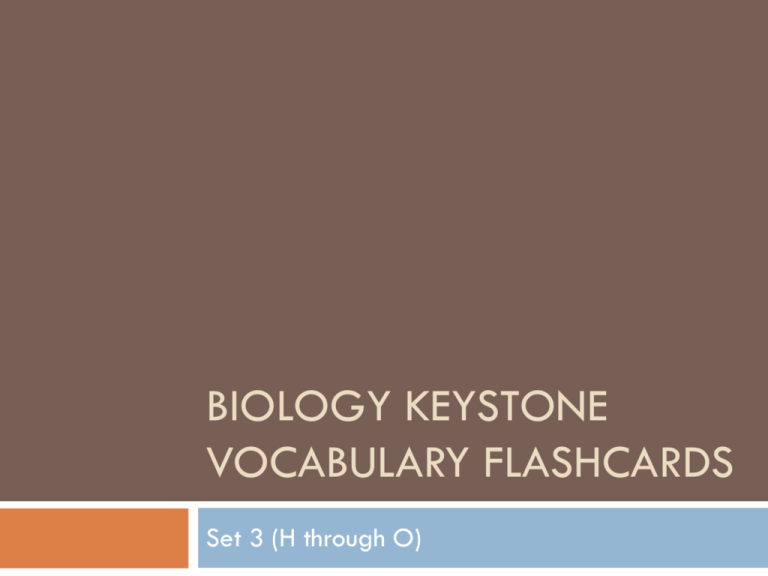
BIOLOGY KEYSTONE VOCABULARY FLASHCARDS Set 3 (H through O) Habitat An area that provides an organism with its basic needs for survival. Homeostasis The regulatory process in which an organism regulates its internal environment. Homeostatic Mechanism A regulatory mechanism that contributes to maintaining a state of equilibrium (e.g., thermoregulation, water regulation, and oxygen regulation). Homologous Structure A physical characteristic in different organisms that is similar because it was inherited from a common ancestor. Hypothesis A proposed, scientifically testable explanation for an observed phenomenon. Impermeable Not permitting passage of a substance or substances. Incomplete Dominance A pattern of inheritance in which two alleles, inherited from the parents, are neither dominant nor recessive. The resulting offspring have a phenotype that is a blending of the parental traits. Inheritance The process in which genetic material is passed from parents to their offspring. Interphase The longest‐lasting phase of the cell cycle in which a cell performs the majority of its functions, such as preparing for nuclear division and cytokinesis. Intracellular Located inside a cell. Isolating Mechanisms Features of behaviors, morphology, or genetics which serve to prevent mating or breeding between two different species (e.g., temporal isolation, in which individuals are active at different times of the day, seasons, or mating periods; ecological isolation, in which individuals only mate in their specific habitat; behavioral isolation, when there are no sexual cues between representatives of the species; mechanical isolation, when there is no sperm transfer during an attempted mating; and gametic incompatibility, when there is sperm transfer without fertilization occurring). If mating can take place, there are four factors that prevent hybrid viability: zygotic mortality (fertilization but no zygote), hybrid inviability (embryo is not viable), hybrid sterility (resulting adult is sterile), and hybrid breakdown (first generation is viable but future generations are not). Law (Scientific) A law that generalizes a body of observations. At the time it is made, no exceptions have been found to a law. It explains things but does not describe them; serves as the basis of scientific principles. Limiting Factor Chemical or physical factor that limits the existence, growth, abundance, or distribution of an individual organism or a population. Lipids A group of organic compounds composed mostly of carbon and hydrogen including a proportionately smaller amount of oxygen; are insoluble in water, serve as a source of stored energy, and are a component of cell membranes. Macromolecule A polymer with a high molecular mass. Within organisms there are four main groups: carbohydrates, lipids, proteins, and nucleic acids. Mechanism (Scientific) The combination of components and processes that serve a common function. Meiosis A two‐phase nuclear division that results in the eventual production of gametes with half the normal number of chromosomes. Migration (Genetics) The permanent movement of genes into or out of a population resulting in a change in allele frequencies. Mitochondrion A membrane‐bound organelle found in most eukaryotic cells; site of cellular respiration. Mitosis A nuclear division resulting in the production of two somatic cells having the same genetic complement as the original cell. Molecule The smallest particle of a substance that retains the chemical and physical properties of the substance and is composed of two or more atoms held together by chemical forces. Monomer A molecule of any compound that can react with other molecules of the same or different compound to form a polymer. Each biological macromolecule has characteristic monomers. Multicellular Made up of more than one cell. Multiple Alleles More than two forms of a gene controlling the expression of a trait. Mutation A permanent transmissible change of genetic material (e.g., chromosomal mutations and gene mutations). Natural Selection A process in nature in which organisms possessing certain inherited traits are better able to survive and reproduce compared to others of their species. Nondisjunction The process in which sister chromatids fail to separate during and after mitosis or meiosis. Nonnative Species A species normally living outside a distribution range that has been introduced through either deliberate or accidental human activity; also can be known as introduced, invasive, alien, nonindigenous, or exotic. Nucleic Acid A biological macromolecule (DNA or RNA) composed of the elements C, H, N, O, and P that carries genetic information. Nucleus A membrane‐bound organelle in eukaryotic cells functioning to maintain the integrity of the genetic material and, through the expression of that material, controlling and regulating cellular activities. Organ An anatomical unit composed of tissues serving a common function. Organ System An anatomical system composed of a group of organs that work together to perform a specific function or task. Organelle A subunit within a cell that has a specialized function. Organic Molecule A molecule containing carbon that is a part of or produced by living systems. Organism A form of life; an animal, plant, fungus, protist or bacterium. Osmosis The movement of water or another solvent through permeable membranes from an area of higher water concentration (dilute) to an area of lower water concentration (concentrated).
